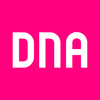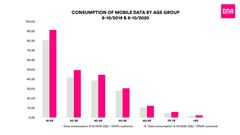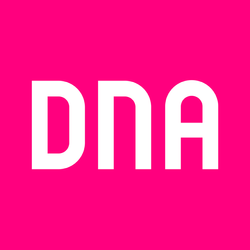DNA’s age group comparison reveals: Mobile data usage is drastically different even between Millennials and Generation Z

The average adult under the age of 30 used more than 91 gigabytes of data on their postpaid subscription between August and October, DNA's data comparison indicates. This age group, which consists of both Millenials and members of Generation Z, was born into a world where electronics and digital services were a central component of everyday life. Young adults who have grown up using digital environments since early childhood have a considerably more routine approach to mobile data usage than Millennials born in the 1980s or early 1990s: DNA’s customers aged 30 to 39 consumed 49 gigabytes of data on average during the same sampling period.
“The comparison reveals that Millennials, who are often thought of as a homogeneous group, are actually very diverse when it comes to data usage. We were also surprised by the huge difference in data usage between the youngest age group and older age groups,” says Pekka Väisänen, Senior Vice President, Consumer Business, DNA.
Young adults use triple the amount of data used by their parents
According to DNA’s statistics, the average 50 to 59-year-old, the age group that typically includes parents of young adults under the age of 30, used approximately 31 gigabytes of data between August and October – which is about a third of the data usage of the average 18 to 29-year-old. The average data usage of other age groups also pales in comparison to the youngest age group: for example, the data usage of an average 40 to 49-year-old was 44 gigabytes during the sampling period.
Compared to the corresponding three-month period of the previous year, the average data usage of young adults increased by more than ten gigabytes per customer. Older age groups also increased their data usage compared to the previous year, but the older the age group was the slower the rate of growth.
“Data is used at an increasing rate which bodes well for 5G. The advantages of the fast-growing 5G mobile broadband include its consistent quality and lack of congestion, thanks to which services run smoothly and you no longer need to spend time staring at the spinning doughnut that indicates buffering. The lack of network delay particularly benefits those playing games on smart devices which is a common activity for young age groups. Games are particularly susceptible to delay and connection speeds are often vital for succeeding in games,” Väisänen notes.
People in their 40s consume proportionally the most video content
The single largest use of data for young adults is video content, which made up 43 percent (39 GB) of the overall data usage of the average adult under the age of 30 during the three-month sampling period. However, the age group proportionately most fond of videos were the 40 to 49-year-olds, as up to 46 percent of their data usage consisted of video content. The previous year, the corresponding percentage for the age group was just 37 percent.
In terms of data volume, young adults use social media (14.8 GB) more than the average users of all other age groups combined. The most notable change in the data usage of young adults is related to music: the data volume used for listening to music shot from 0.5 percent to 1.2 percent in a year, which means that its relative share more than doubled.
“The data supports the notion that younger user groups adopt new digital services and applications earlier than older user groups. Older users later follow the path set out by younger users, which in turn pushes young people to create new digital trends. For example, Facebook was first used by young people, but when their parents found the platform, many young people moved onto Instagram. When the same happened in Instagram, young people migrated to Snapchat and TikTok. The same model and the emergence of new services is sure to continue and even accelerate with 5G access,” Väisänen predicts.
The population coverage of DNA’s 5G network will exceed 1.5 million people this month, and the rapid construction will continue all around Finland throughout the winter.
DNA’s statistical analysis only includes DNA’s postpaid subscriptions on mobile phones for which the owner and the user of the subscription are the same person. Only the most well-known video, audio and social media channels are included.
Further information for the media:
Pekka Väisänen, Senior Vice President, Consumer Business, DNA Plc, tel. +358 (0)44 0400 168, pekka.vaisanen@dna.fi
DNA Corporate Communications, tel. +358 (0)44 044 8000, viestinta@dna.fi
Images
Links
About DNA Oyj
DNA is one of the leading telecommunications companies in Finland. We want to make our customers' daily lives less complicated. We offer connections, services and devices for homes and workplaces, contributing to the digitalisation of society. DNA's customers are continuously among the world mobile data usage leaders. We are Finland's largest cable TV operator. DNA has more than 4 million subscriptions in its fixed and mobile communications networks. The company was ranked the best employer in Finland in the large companies category of the 2019 Great Place to Work survey. In 2019, our net sales were EUR 942 million and we employ about 1,600 people around Finland. DNA is a part of Telenor Group, a leading telecommunications company across the Nordics. More information: www.dna.fi, Twitter @DNA_fi, Facebook @DNA.fi and LinkedIn @DNA-Oyj.
Subscribe to releases from DNA Oyj
Subscribe to all the latest releases from DNA Oyj by registering your e-mail address below. You can unsubscribe at any time.
Latest releases from DNA Oyj
DNA:n jättitilasto: Näin eri ikäryhmät 50 suurimmassa kunnassa käyttävät kännykkää20.11.2025 10:30:00 EET | Tiedote
Suomalaiset kuluttavat mobiilidataa ennätysmäärin, ja esimerkiksi nuorten kännykkänetin keskikäyttö riittää jo tuntien videokatseluun päivittäin. DNA:n vertailu 50 suurimman kunnan välillä tammi–lokakuussa 2025 paljastaa yllättäviäkin eroja kuntien ja ikäryhmien välillä puhelimilla käytetyissä datamäärissä. Keskimääräisesti ykkösenä on Rovaniemi. Katso jättitilasto tiedotteen lopusta.
DNA’s Statistics: How Different Age Groups in Finland’s 50 Largest Municipalities Use Mobile Phones20.11.2025 10:30:00 EET | Press release
Finns consume mobile data at record levels, and for example, the average mobile internet use among young people already allows for hours of video viewing daily. DNA’s comparison of the 50 largest municipalities between January and October 2025 reveals surprising differences between municipalities and age groups in the amount of data used on phones. On average, Rovaniemi tops the list. Check the full statistics at the end of the release.
DNA:n lokakuun 2025 myydyimmät puhelimet ja älykellot3.11.2025 08:00:00 EET | Tiedote
DNA:n lokakuun myydyimmäksi puhelimeksi nousi Applen edullisin iPhone 16e 5G. Myös Applen uutuudet säilyivät listalla, mutta tippuivat sijoituksissa jo alemmaksi. Yritysasiakkaiden puolella Samsung nousi pitkästä aikaa listan kärkeen, kun ykkössijan otti Samsung Galaxy A26 5G. Älykelloissa myydyimmät jakautuivat laajasti eri valmistajien välillä ja ensimmäisen sijan vei tällä kertaa Honor Watch 2i.
Uudet turvallisen nettiselauksen liittymät estäneet jo yli 7 miljoonaa huijausyritystä31.10.2025 10:00:00 EET | Tiedote
Uuden ajan DNA Huoleton puhelin- ja laajakaistaliittymät sekä Varma -yritysliittymät ovat herättäneet paljon mielenkiintoa. Ne sisältävät turvallisen nettiselauksen, joka estää asiakkaita joutumasta haitallisille verkkosivuille. Turvallinen nettiselaus on tehokas suoja verkossa tapahtuvia huijauksia vastaan, ja ominaisuuden avulla onkin saatu estettyä edeltävän puolivuotisen eli touko-lokakuun aikana liittymien käyttäjiltä jo 7,6 miljoonaa huijausyritystä.
New subscriptions with secure internet browsing have already blocked over 7 million scam attempts31.10.2025 10:00:00 EET | Press release
The new DNA Huoleton mobile and broadband subscriptions, as well as Varma business subscriptions, have attracted significant interest. They include secure internet browsing, a feature that prevents customers from accessing harmful websites. Secure internet browsing is an effective safeguard against online scams, and during the past six months from May to October it has already blocked 7,6 million scam attempts for subscription users.
In our pressroom you can read all our latest releases, find our press contacts, images, documents and other relevant information about us.
Visit our pressroom


